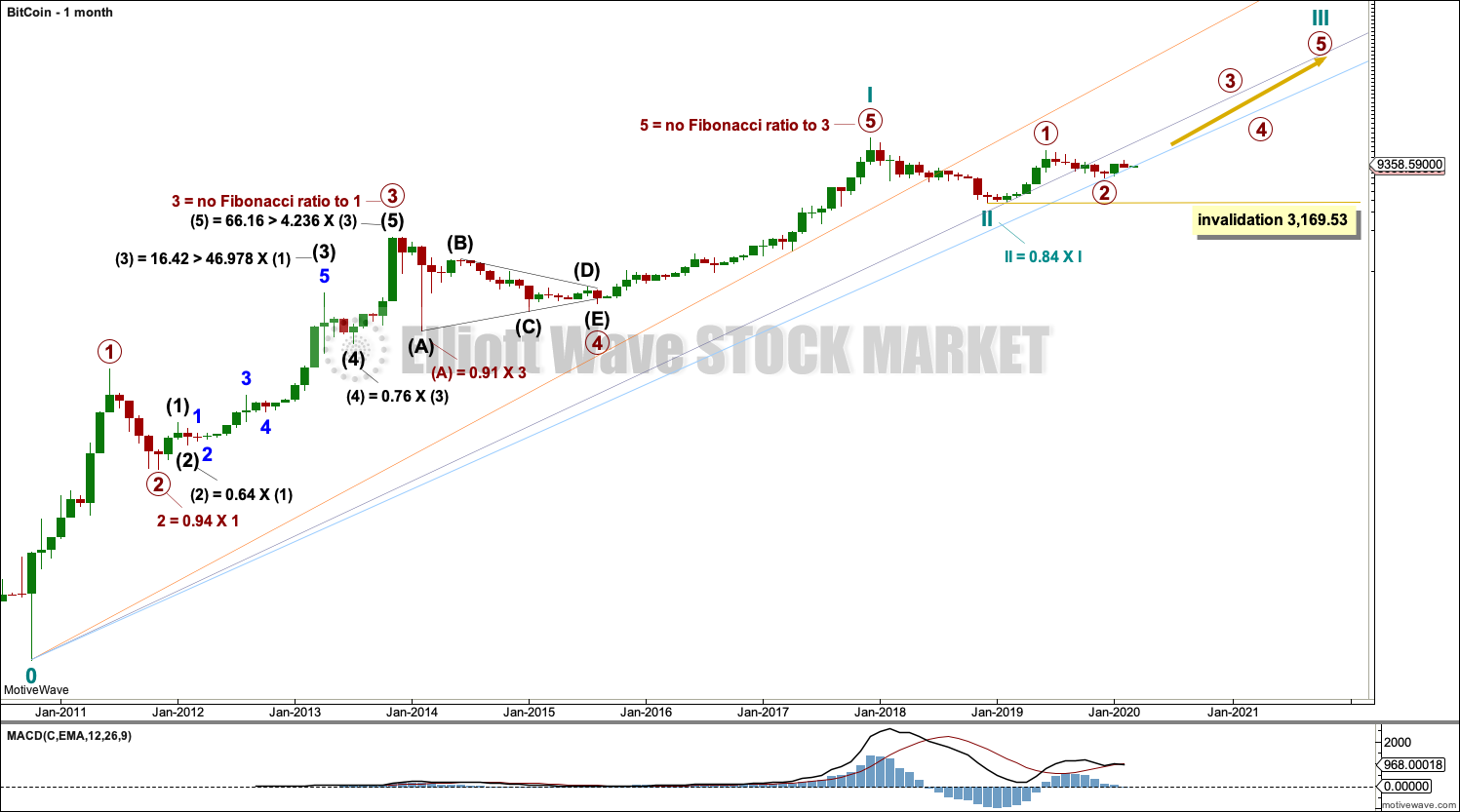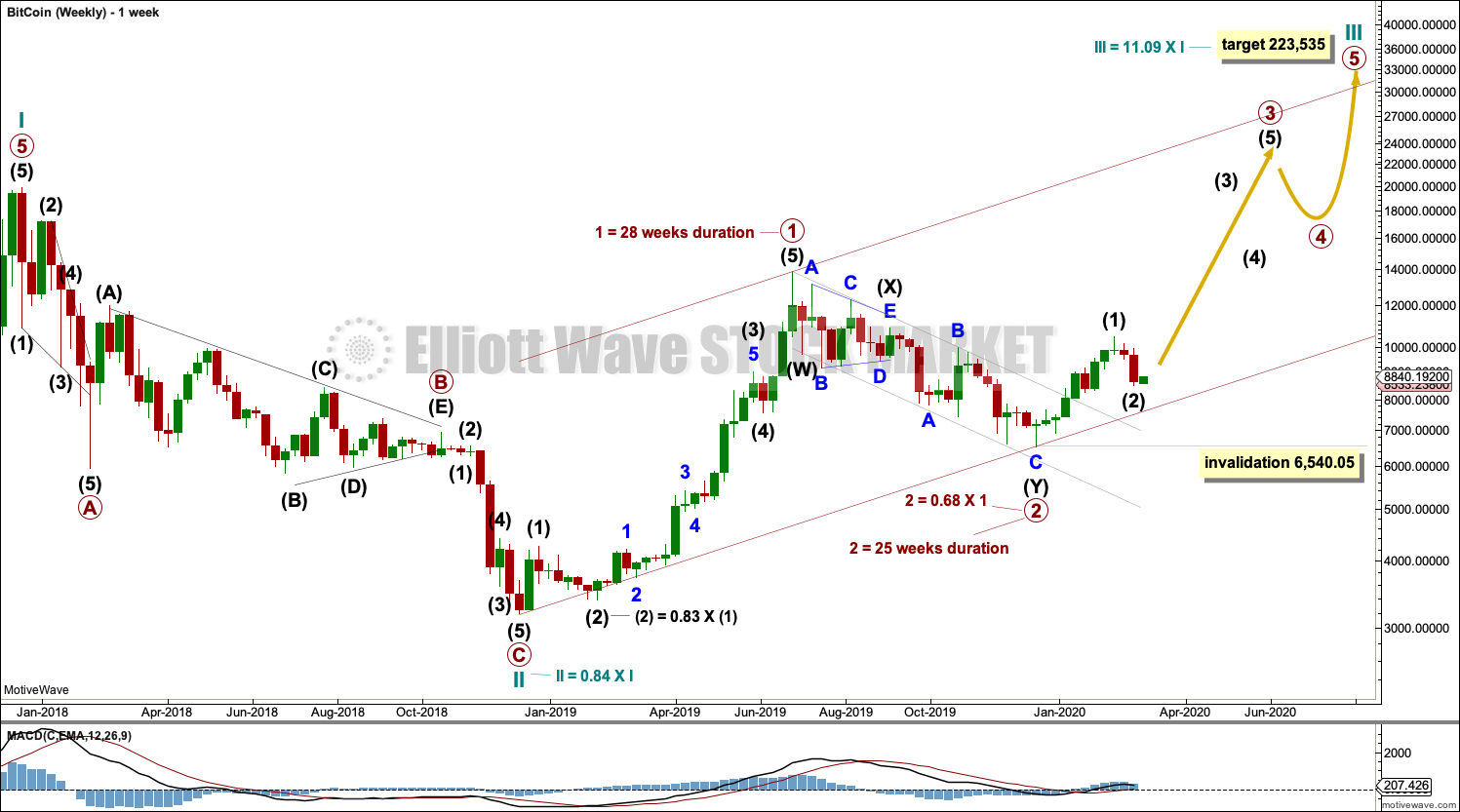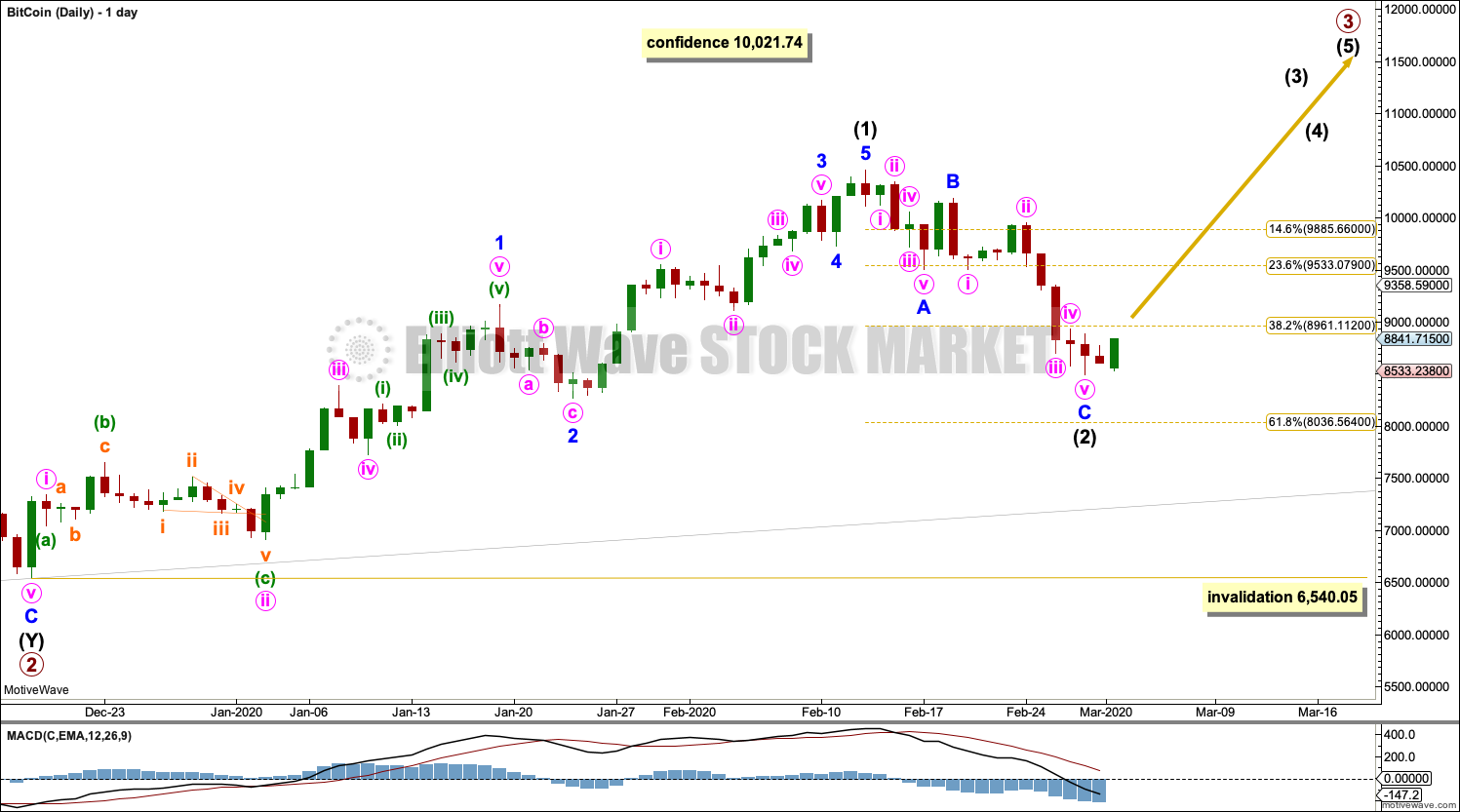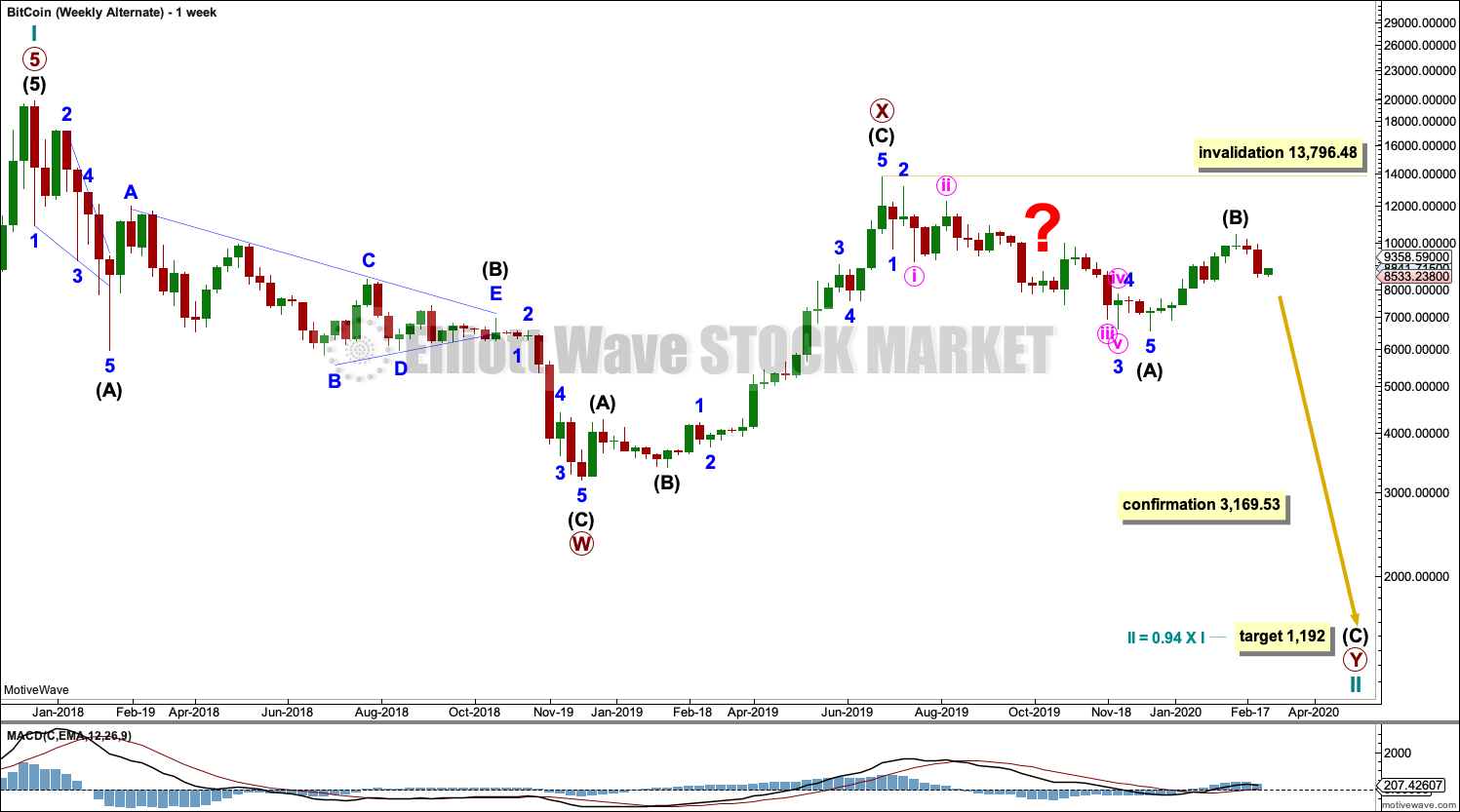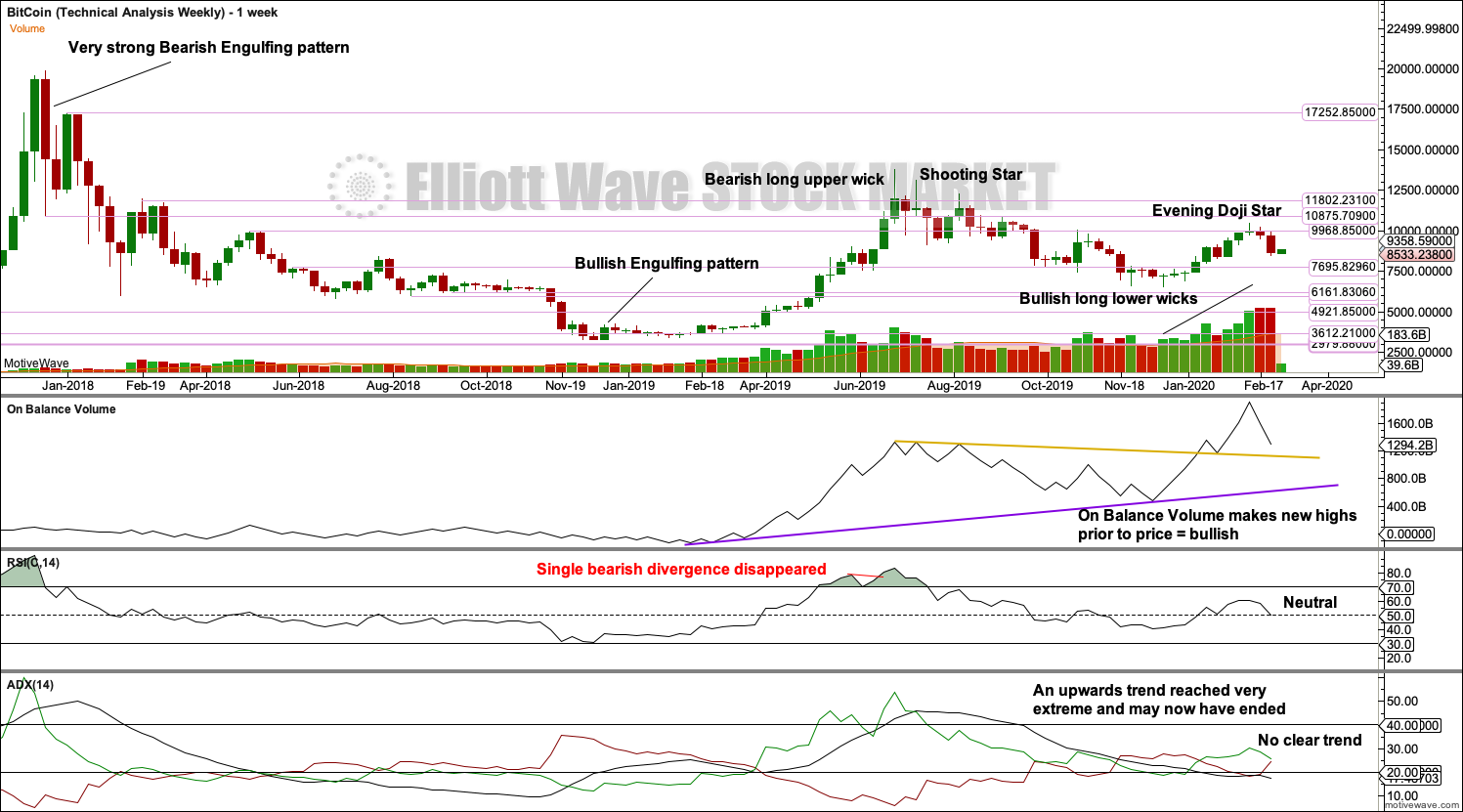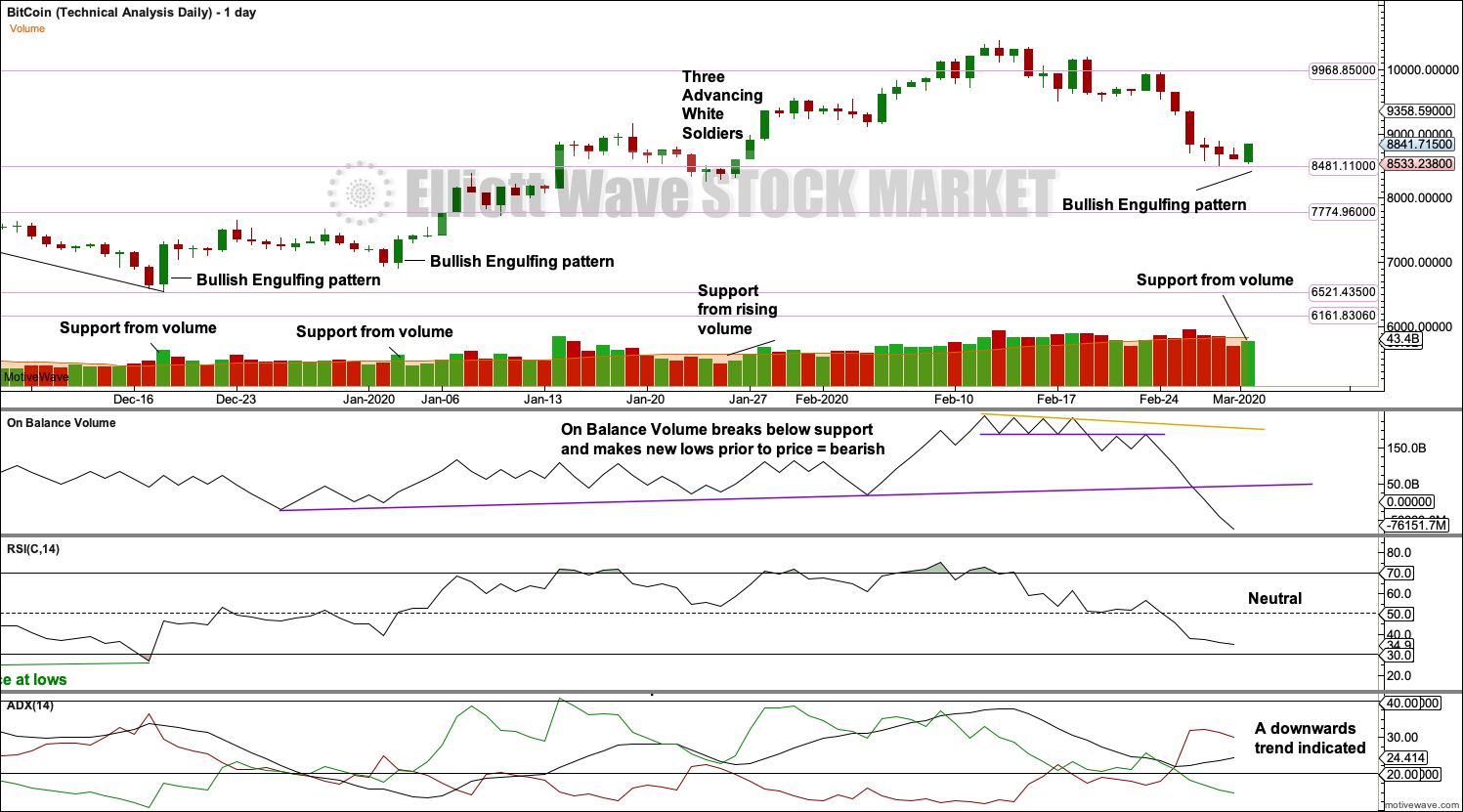BTCUSD: Elliott Wave and Technical Analysis | Charts – March 2, 2020
Last analysis on January 30, 2020 expected overall upwards movement to complete a first wave, which could then be followed by a second wave correction. This is overall what has happened
Summary: A sustainable low looks to now be in place. Further confidence may be had in this view if Bitcoin can make a new high above 10,021.74. Support may now hold at 6,540.05.
The data used for this analysis comes from Yahoo Finance BTC-USD.
Monthly and weekly charts are on a semi-log scale. The close up daily chart is on an arithmetic scale.
MAIN ELLIOTT WAVE COUNT
MONTHLY
It is possible to see a completed five wave impulse upwards for Bitcoin.
I am unable to find many reasonable Fibonacci ratios within this wave count. It appears that Bitcoin may not exhibit Fibonacci ratios very often between its waves, so this makes target calculation impossible. Classic technical analysis was used to identify a high in place on December 23, 2017.
What is very clear from this chart is that Bitcoin forms classic bubbles. It has done so now several times and may now be doing so again. So far each bubble has popped and Bitcoin has collapsed, to then thereafter form a new bubble. Each bubble is larger than the one prior; so if another Bitcoin bubble is forming, it may be expected to take price substantially above the all time high.
Bitcoin tends to behave like an extreme commodity: price moves upwards for about 2 – 4 weeks in a near vertical movement at the end of its rises. Following this vertical movement the resulting downwards movement is very deep (in percentage terms) and often very quick.
The next rise begins slowly with basing action over weeks or months, and then as the rise nears its end another vertical movement completes it. Also, there are volume spikes just before or at the end, which is another feature typical of commodity like behaviour.
This has happened now several times. The most notable instances are the rise up to the week ending 24th November, 2013, and the week ending 5th June, 2011. The following sharp drops were 94% and 93% respectively.
The last instance was the rise up to the last all time high for Bitcoin at 19,870.62 on the 17th of December 2017. The drop thereafter may now be considered as highly likely to be complete. If the drop is complete, it was only an 84% drop.
WEEKLY
Cycle wave II may be a complete zigzag.
Cycle wave III must move above the end of cycle wave I at 19,870.62. It must move far enough above this point to allow room for cycle wave IV to unfold and remain above cycle wave I price territory.
Cycle wave I lasted 7.2 years and cycle wave II may have been over within just under one year. It would be reasonable to expect cycle wave III to last about 7 years, possibly a Fibonacci 8 or 13 years. At this stage, it may be now within its twelfth month.
Cycle wave III must unfold as a simple five wave impulse, and within this impulse there should be two large corrections for primary waves 2 and 4. So far primary waves 1 and now 2 may be complete. Primary wave 2 may have exhibited a duration close to primary wave 1 and ended just a little lower than the 0.618 Fibonacci ratio. Primary wave 2 subdivides as a double zigzag.
If this wave count is correct, then a third wave up at two large degrees may have just begun. Targets will not be calculated as Bitcoin does not reliably exhibit Fibonacci ratios, so classic technical analysis will again be used to identify the next major high in place.
Primary wave 3 would very likely be much longer than 4.236 times the length of primary wave 1. Primary wave 3 would very likely end with a blow off top after a vertical rise of 2 to 4 weeks. Primary wave 3 must move far enough above primary wave 1 to allow room for primary wave 4 to unfold and remain above primary wave 1 price territory.
Within primary wave 3, intermediate wave (2) may not move beyond the start of intermediate wave (1) below 6,540.05.
Draw a base channel about primary waves 1 and 2 as shown. The lower edge may provide support if intermediate wave (2) moves lower. The power of a strong third wave may breach the upper edge of this channel.
DAILY
Within primary wave 3, at this stage, intermediate waves (1) and (2) may be complete.
Intermediate wave (2) has ended close to the 0.5 ratio (not a Fibonacci ratio) of intermediate wave (1). It is possible that intermediate wave (2) may not be over and may continue lower as a double zigzag to end closer to the 0.618 Fibonacci ratio of intermediate wave (1). Intermediate wave (2) may not move beyond the start of intermediate wave (1) below 6,540.05.
WEEKLY – ALTERNATE
If the degree of labelling within cycle wave II is moved down one degree, it is possible that cycle wave II may be an incomplete double zigzag.
While this wave count is technically possible, it does not have support from volume analysis.
The upwards wave labelled primary wave X on this chart should exhibit reasonable weakness for this wave count to make sense. It does not. Volume strongly supported that upwards movement. It looks impulsive, not corrective.
There is now an Elliott wave problem within this wave count: The zigzag of primary wave Y should subdivide 5-3-5, but intermediate wave (A) will not subdivide well as a five (the piece of movement which does not fit for this wave count is noted with a large red ?). This wave count is now forced.
TECHNICAL ANALYSIS
WEEKLY
The following characteristics can be noted at the end of prior major highs for Bitcoin:
The first sharp rise to the week beginning 5th June 2011: near vertical movement for several weeks, a sharp volume spike for a blow off top on the final week, and no candlestick reversal pattern on the weekly chart but an Evening Doji Star on the daily chart. The following correction was 0.94.
The next sharp rise to the week beginning 7th April 2013: near vertical movement for three weeks, a sharp volume spike on the final week that closed red and formed a Bearish Engulfing pattern on the weekly chart, a Bearish Engulfing pattern on the daily chart, ADX remained very extreme for most of the rise, and single week bearish divergence between price and RSI at the end. The following correction was 0.82.
The next sharp rise to the week beginning 24th November 2013: vertical movement for four weeks, a strong rise in volume until the last week (which saw volume fall), a Bearish Engulfing pattern on the weekly chart, an Evening Doji Star on the daily chart (the third candlestick of which had strong support from volume), ADX reached very extreme for many days, and RSI reached extreme overbought and there exhibited single bearish divergence. The following correction was 0.93.
The last sharp rise to the all time high at 19,870.62 on the 17th of December 2018: vertical movement for three weeks, a strong increase in volume up to the last week (which saw a fall in volume), a Bearish Engulfing pattern on the weekly chart that had support from volume; on the daily chart, ADX reached very extreme for a coupe of weeks or so, RSI reached overbought and there exhibited single bearish divergence, and early downwards movement from the high had support from volume. The following correction was 0.84.
Some conclusions may be drawn about how to identify a major high in Bitcoin:
– Look for vertical movement on the weekly chart for at least two weeks, and possibly up to several (although when it is more than three the movement may be interspaced with a small pause).
– Look for either a sharp volume spike for a blow off top, or a strong increase in volume then followed by a single week of lighter volume at the possible high.
– A bearish candlestick reversal pattern has been seen so far at every major high for Bitcoin, so an absence of any candlestick reversal pattern at a potential high should be viewed very suspiciously.
– ADX is of no use as it may remain very extreme for long periods of time.
– RSI may also remain very extreme for long periods of time and may not exhibit any divergence, but it may add a little confidence in the high if it does exhibit bearish divergence in conjunction with other indicators being bearish.
The last vertical rise to June 2019 now exhibits enough of the points looked for to have some confidence that Bitcoin may have found an interim top: vertical movement for three weeks, a volume spike on the last week, and a very bearish long upper wick on the candlestick at the high, although this is not a candlestick reversal pattern.
DAILY
The following can be noted when looking back at Bitcoin’s behaviour during its previous strong falls in price:
The 94% fall in price from June to November 2011 was characterised by:
– Three clearly separate instances of RSI reaching oversold on the daily chart, separated by bounces.
– ADX did not remain very extreme for very long at all on the daily chart.
– On Balance Volume exhibited weak single bullish divergence at the low.
The 93% fall in price from November 2013 to February 2014 was characterised by:
– RSI reached oversold and remained deeply oversold for three weeks; at the low, there was only single weak bullish divergence with price.
– ADX remained very extreme for the last seven sessions to the low.
– At the low, On Balance Volume did not exhibit bullish divergence with price. It remained bearish and then exhibited further bearishness after the low as it continued to decline as price began to rise.
The 84% fall in price from December 2017 to December 2018 was characterised by:
– RSI reached deeply oversold and then exhibited double divergence with price.
– ADX reached very extreme 20 sessions prior to the low.
– At the low, On Balance Volume exhibits no bullish divergence with price; it turned with price.
At this last low now on December 19, 2019, the following can be noted:
– A strong Bullish Engulfing candlestick pattern which had support from volume.
– Bullish divergence between price and On Balance Volume.
– Bullish divergence between price and RSI after RSI reached reasonably oversold.
– ADX reached extreme for the downwards trend 20 days prior to the low.
Now there are signs of strength in following upwards movement:
– A second strong Bullish Engulfing candlestick pattern with support from volume.
– A bullish signal from On Balance Volume.
– A very strong bullish candlestick pattern in Three Advancing White Soldiers that has strong support from volume.
– Another Bullish Engulfing candlestick pattern has appeared on the 2nd of March, which has support from volume.
When Bitcoin has a strong upwards trend, RSI can reach deeply overbought and remain there for some time. Sometimes it may exhibit some bearish divergence which then disappears as price continues higher. Additionally, ADX can reach very extreme and remain there for a long period of time.
Published @ 01:19 p.m. EST.
—
Careful risk management protects your trading account(s).
Follow my two Golden Rules:
1. Always trade with stops.
2. Risk only 1-5% of equity on any one trade.
—
New updates to this analysis are in bold.

